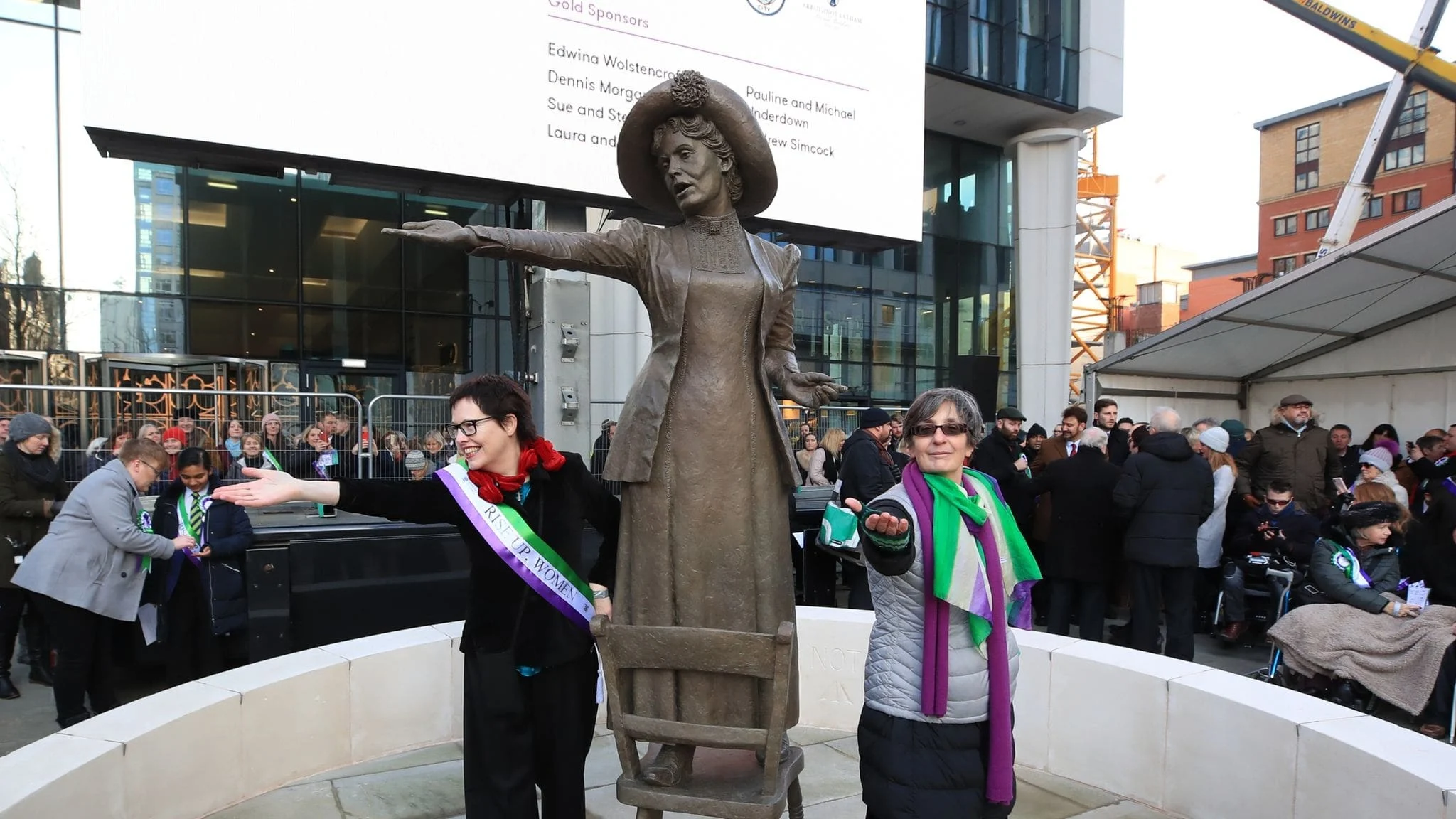Is it time men stay in their lane?


TLDR? Listen instead.
I believe in equality and celebrate any progress towards a fairer and more equal society. Naturally, this resulted in some mixed emotions for me regarding two stories in Scotland recently. First, to Dundee where the story centred around the appointment of Jason Grant - a man - as Period Dignity Regional Lead Officer at Dundee and Angus College. This caused such an outcry of rage that the story made it to The New York Times. A few weeks later a competition to design a statue of Elsie Inglis on the Royal Mile in Edinburgh was scrapped in favour of Professor Alexander Stoddart (the royal sculptor) being commissioned instead. Elsie Inglis was a “physician, surgeon, humanitarian, feminist, and pioneer of medical education for women” who played a “notable role in the establishment of the Scottish Women's Suffrage Federation”. As with Grant, the royal sculptor is male. Whilst much of the anger was in response to the scrapping of a competition already underway for designers to bid for the project, there was also a feeling of distaste that a statue honouring a suffragette would be designed by a man.
The moment I saw the rage online, I grabbed my virtual pitchfork and joined the fray. While I seethed and started to type frantically, a whisper of a thought flickered through my mind - am I a hypocrite…? Am I being prejudicial towards these men? That led me to the next dreadful thought - if I believe some roles should be reserved for women, does that mean ergo that some roles can be reserved for men? Does that mean that some roles should be reserved for men? I had to leave the pitchfork for a minute and dig a bit deeper into this one.
Grant was appointed to “...implement the legal right to free period products in public settings”. News of this spread quickly this summer, as stories such as this are wont to do in our age of social media, and hit international newsstands. Scotland also made international headlines earlier this year with the history-making decision to enshrine an obligation, for period products to be available for free in public settings such as councils and schools, in law.

Whilst the outcry over Grant’s role was certainly focused on the gender of the person appointed, Stoddart’s appointment angered many because those entering the competition had spent time preparing their designs. Would the cries of injustice have been so loud had the sculptor selected been female? We’ll never know. What I do know is that these two stories broke within weeks of each other and have left me pondering which side of the fence I land on. It certainly seems a strange notion on the first read that we’ve fought for equality for so long, to turn around and say “ah, but only one gender can do this particular role - sorry!”.
In the UK we have a statutory exemption under The Equality Act 2010 that allows discrimination against people with a particular characteristic when deciding who to employ. Schedule 9, Part 1 of the Act permits the advertising of a role and employment of women (or men!) only for specific functions which satisfy this exemption. This can lead to single-sex workplaces such as women’s charities that provide domestic abuse or sexual assault support and care, for example. Suggesting that should either of these two controversial roles satisfy the statutory exemption, they could have been limited to female-only applicants.
The nuance of roles such as a newly designated ‘Period Dignity Officer’ or designer of a suffragette statue makes this a tricky topic. It is arguable that a man, who has never physically experienced menstruation, will not understand the needs of the women he serves in this role. The idea that a man would be mansplaining periods to women was met with incredulity online. The flip side of this is that for centuries, men have occupied and continue to occupy positions relative to female reproductive health such as gynaecology or midwifery. I’m confident that most health representatives have had the requisite training and education. They are governed, or are members of a licensed body, and are expected to learn and develop as they work. Perhaps Grant had special training or experience that made him the most appropriate candidate for this role. He, too, would continue to learn and develop as he worked. Except the media reports suggested otherwise. Even if he did, it is well-reported that women benefit from being treated in medical settings by female physicians, and I would extend that to include the implementation of menstruation care.
Given the artistic freedom available for a statue on the Royal Mile is likely to be limited, a woman instead of a man may have been a reasonable place to start.
Ultimately, the issue here is beyond the anatomy of a female body and its differences from that of the male. It’s the intersectional experiences of women biologically and socially that need to be represented. Ideally, a board of women representing the intersections of race, ethnicity and class, among other social characteristics would occupy the period dignity role. In the face of potentially limited resources in a public body, a woman instead of a man would have been a reasonable place to start. Ideally, a group of women from different backgrounds would collaborate on the design and creation of a suffragette statue. Given the artistic freedom available for a statue on the Royal Mile is likely to be limited, a woman instead of a man may have been a reasonable place to start. Fundamentally, I believe the issue is quite simple. Women have suffered inequality and continue to do so. As we commemorate the past struggles against inequality and continue to fight against it today, we ought not to further the privilege of men.
Without consideration of these points, it’s questionable what the purpose of the undertaking is. The gesture becomes a gimmick. The actions become performative, falling under the marketing department as good PR rather than a true attempt to implement historic legislation and engage with the local female community. An attempt to be progressive and undo the historical inequality women have faced, on the one hand, limits the role women can have in that progressiveness with the other. The idea that an organisation would not be prepared for the sort of backlash we have seen internationally to these decisions in Scotland suggests a wilful blindness to the true position of today’s women. It demonstrates an indifference to the work still needed. It screams that we have not come far enough and still have a long way to go.

Ian Blackford, the SNP’s (former) leader at Westminster, was interviewed on Grant’s appointment by Sky News. He is quoted as stating: “…as a principle, it would be far better that women are in these posts than anyone else”. He makes a valid point. As a point of principle, it would be far better. For hundreds of years, the loudest voices have been that of white, heterosexual men. Women have been let down time and time again by the lack of a voice and by being categorised as ‘less than’. The research into female-specific health issues has been underfunded, the representation on company boards minimal and protection from systemic misogyny non-existent. It seems almost the bare minimum in that context to ensure a woman fills the role that exists to give a voice to the previously voiceless and to honour a suffragette with the furtherance of a fellow woman’s career.
It is performative to create a period dignity role or erect a statue of a suffragette if those intentions are not principled. It’s performative to place a woman in either role if they’re simply the face of it. It’s all performative if it isn’t backed up by action to elevate the position of women, especially marginalised women, in society. The first step in progressing that position would certainly be to put women in these positions in the first place. Was I right to immediately reach for my virtual pitchfork? I’d say so.
On the face of it, it might be hypocritical to suggest that certain roles should be reserved for women whilst being outraged that any role would be reserved for a man. Some might accuse me of trying to further the position of women alone and of having left equality far behind. I hope this article has shown you that this isn’t the case. We will never tackle inequality if we simply take the view that women can never have some privilege over men and that they should always begin from the same starting block. It follows then, that I don’t believe I am being prejudicial to these men and whilst some roles can be reserved for men (hello, Equality Act), that doesn’t mean they should (unless, they meet the exemptions set out in law, of course).
Why? Well, I’d point you to the difference between equality and equity and this brilliant article by George Washington University’s Milken Institute School of Public Health. Essentially, equality means that everyone has the same opportunity or resources. Equity, on the other hand, looks more proportionally at the opportunities, or resources and ensures a proportional distribution to ensure a fairer result for all involved. Treating men and women equally, and never reserving a role exclusively for women without also giving men the same treatment, still leaves women one step behind. To treat men and women equitably means giving women that boost to give them a shot at equality.
Written by
Hannah LeslieScottish lawyer, bibliophile and feminist. Love to travel, by plane or by my imagination. Often found surrounded by four-legged pals.
Read next
What men really think about the 'Male Pill'

Archie Rankin
We need to talk about Toxic Masculinity

Matt Donno
Let's end journalism's elitism

Louisa
Weekly emails
Get more from Hannah
The Fledger was born out of a deep-seated belief in the power of young voices. Get relevant views on topics you care about direct to your inbox each week.
Write at The Fledger
Disagree with Hannah?
Have an article in mind? The Fledger is open to voices from all backgrounds. Get in touch and give your words flight.
Write the Contrast